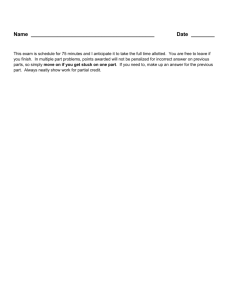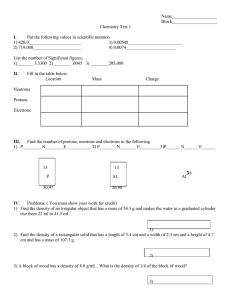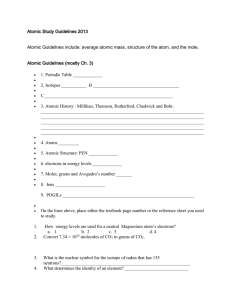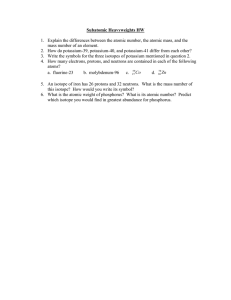1. In 1909, the English physicist Ernest Rutherford conducted a
advertisement
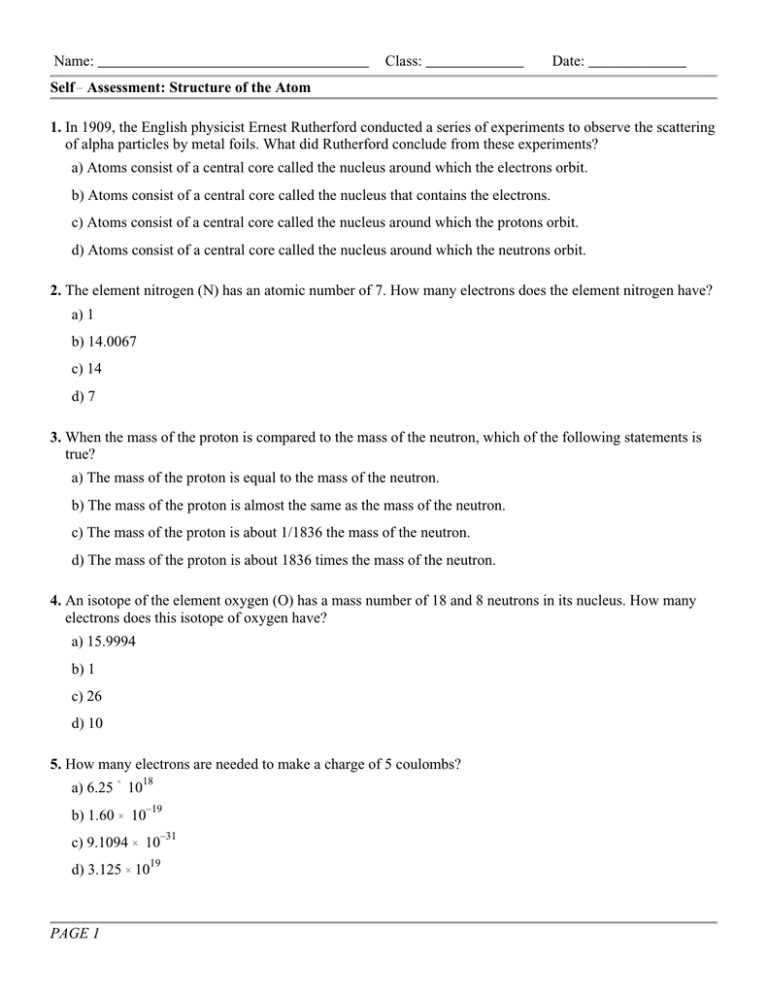
Name: ____________________________________ Class: _____________ Date: _____________ Self Assessment: Structure of the Atom 1. In 1909, the English physicist Ernest Rutherford conducted a series of experiments to observe the scattering of alpha particles by metal foils. What did Rutherford conclude from these experiments? a) Atoms consist of a central core called the nucleus around which the electrons orbit. b) Atoms consist of a central core called the nucleus that contains the electrons. c) Atoms consist of a central core called the nucleus around which the protons orbit. d) Atoms consist of a central core called the nucleus around which the neutrons orbit. 2. The element nitrogen (N) has an atomic number of 7. How many electrons does the element nitrogen have? a) 1 b) 14.0067 c) 14 d) 7 3. When the mass of the proton is compared to the mass of the neutron, which of the following statements is true? a) The mass of the proton is equal to the mass of the neutron. b) The mass of the proton is almost the same as the mass of the neutron. c) The mass of the proton is about 1/1836 the mass of the neutron. d) The mass of the proton is about 1836 times the mass of the neutron. 4. An isotope of the element oxygen (O) has a mass number of 18 and 8 neutrons in its nucleus. How many electrons does this isotope of oxygen have? a) 15.9994 b) 1 c) 26 d) 10 5. How many electrons are needed to make a charge of 5 coulombs? 18 a) 6.25 10 –19 b) 1.60 10 –31 c) 9.1094 10 19 d) 3.125 10 PAGE 1 Name: ____________________________________ Class: _____________ Date: _____________ Self Assessment: Structure of the Atom 6. The atomic number for the element boron (B) is 5. An isotope of boron has a mass number of 10. How many neutrons are present in this isotope of boron? a) 10.81 b) 15 c) 1 d) 5 7. How many electrons does 1.00 gram of electrons contain? 23 a) 5.99 10 18 b) 6.25 10 –19 c) 1.60 10 27 d) 1.10 10 8. Which scientist theorized that atoms consist of a central core called the nucleus around which the electrons orbit? a) Joseph Thompson b) Ernest Rutherford c) Werner Heisenberg d) Niels Bohr 9. The isotope deuterium has 1 neutron and an atomic number of 1. What is the mass number for deuterium? a) 1.00794 b) 1 c) 0 d) 2 PAGE 2 Name: ____________________________________ Class: _____________ Date: _____________ Self Assessment: Structure of the Atom 10. Suppose that element X has an atomic number of 15 and two isotopes called isotope 1 and isotope 2. Isotope 1 of element X has 16 neutrons and isotope 2 of element X has 24 neutrons. Suppose that in a natural sample of element X about 65% of the atoms are of isotope 1 and about 35% of the atoms are of isotope 2. What is the atomic mass of element X? a) 15 b) 33.8 c) 35.5 d) 27 PAGE 3 ANSWER KEY 1. a 2. d 3. b 4. d 5. d 6. d ANSWER KEY Page 1 7. d 8. b 9. d 10. b

